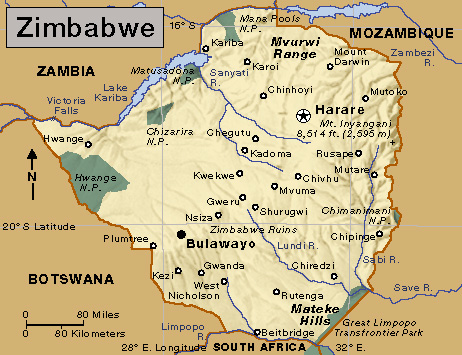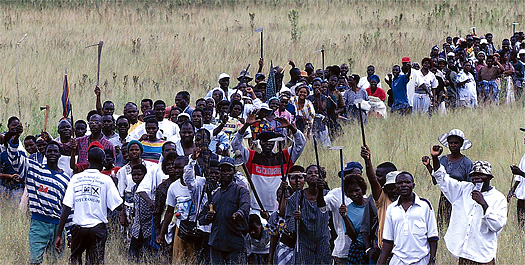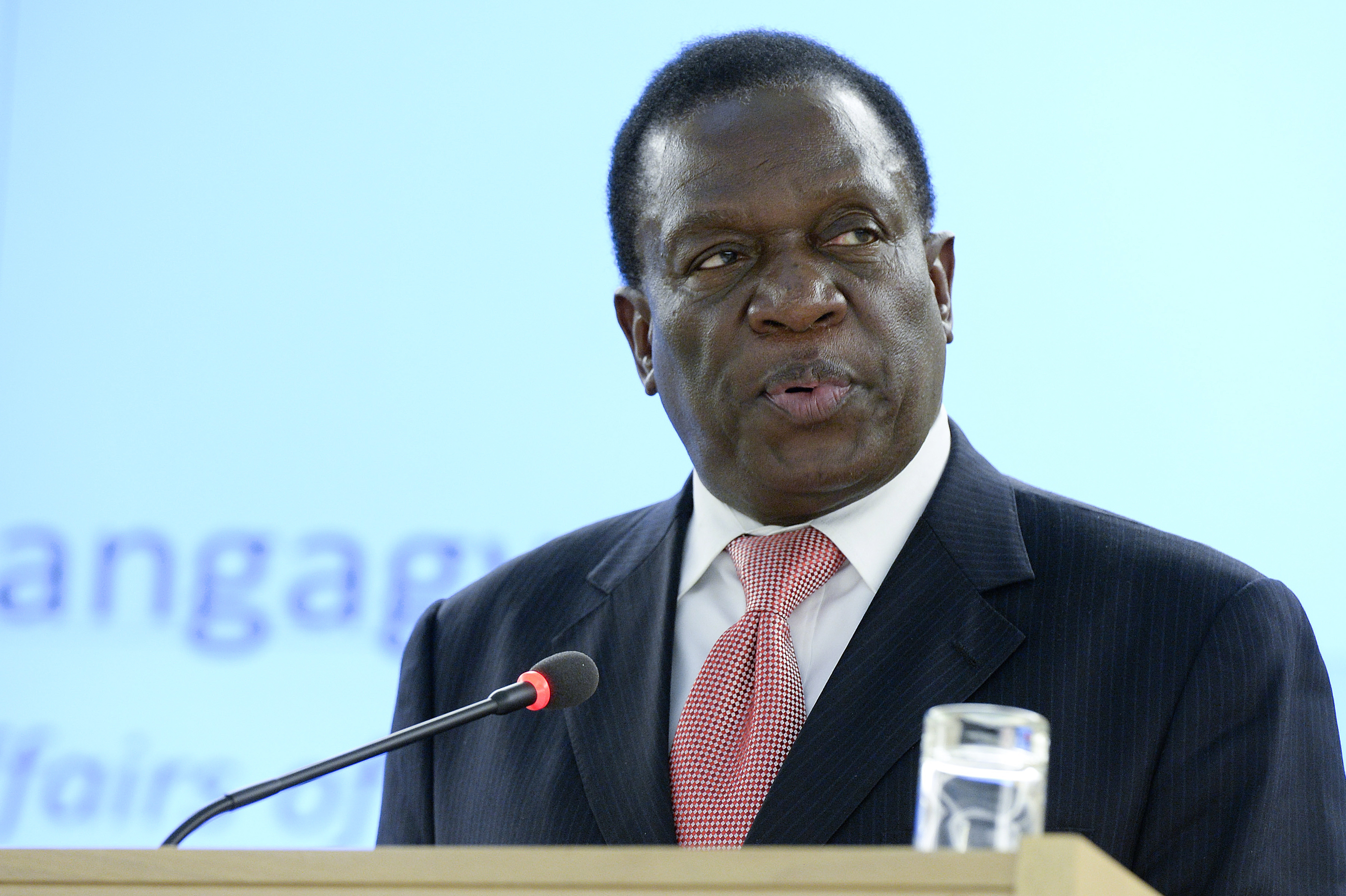Zimbabwe << zihm BAH bway >> is a landlocked country in southern Africa. Most of the country is a high plateau. Zimbabwe lies in the tropics but has a pleasant climate because of the high altitude. Zimbabwe’s beautiful scenery includes the famous Victoria Falls on the Zambezi River along the country’s northern border. Zimbabwe is a leading mineral producer. Harare is the capital and largest city.

Since the late 1800’s, the area that is now the country of Zimbabwe has had a troubled, often violent, political history. The vast majority of Zimbabwe’s people are Black Africans, but whites controlled the government and economy from about 1890 to 1979. During the last decade of white rule, Black nationalists in Zimbabwe—then called Rhodesia—engaged in guerrilla warfare against the government. At the same time, the nation’s economy was crippled by international trade sanctions (restrictions).

In the face of mounting opposition both at home and abroad, white Rhodesians finally agreed to hand over political power to the Blacks. The first Black-majority government was elected in 1979. However, many Blacks rejected this government because they felt it was unrepresentative and allowed whites to retain many special privileges.
Widespread guerrilla violence continued until late 1979, when the government and the rebels signed a peace treaty. In return for a cease-fire, the government agreed to hold new elections in February 1980. The political party of Robert Mugabe, one of the principal rebel leaders, won a large majority of votes in these elections. Mugabe then became prime minister of the independent republic of Zimbabwe.
Government.
Zimbabwe’s government is headed by an executive president who acts as head of state and leads the government. The executive president and two vice presidents are elected for a five-year term. The vice presidents and a Cabinet, appointed by the president, carry out government operations.

Zimbabwe’s Parliament consists of a 270-member House of Assembly and an 80-member Senate. The members of the House are elected by the people and serve five-year terms. In the Senate, 60 members are elected by the people, 18 members are traditional chiefs, and two members represent people with disabilities. Senate members serve five years.
People.
About 98 percent of Zimbabweans are Black people of African ancestry. About 1 percent are of Asian ancestry or are Coloureds (people of mixed ancestry). The rest are white people of European ancestry. About two-thirds of the Blacks live in rural areas. Most of the whites, Asians, and Coloureds live in cities and towns. The largest African ethnic group in Zimbabwe is the Shona (often called the Mashona). The Ndebele (often called the Matabele) is the second largest group. The Shona speak a language called chiShona, and the Ndebele speak isiNdebele.
Loading the player...Zimbabwean traditional music
Most Blacks in Zimbabwe are farmers. Most of them raise only enough food for their families. Their main crop, corn, is pounded into flour to make a dish called sadza.
Land and climate.
Most of Zimbabwe is a high, rolling plateau from 3,000 to 5,000 feet (910 to 1,500 meters) above sea level. The Highveld, a central plateau, crosses the country from northeast to southwest. The Middleveld lies on either side of the Highveld. The Lowveld consists of sandy plains in the Zambezi, Limpopo, and Sabi river basins. Mount Inyangani (8,514 feet, or 2,595 meters) is Zimbabwe’s highest point.
Zimbabwe’s summer lasts from October to April and is hot and wet. The winter, from May to September, is cool and dry. Average temperatures in the country range between 54 and 85 °F (12 and 29 °C), and average rainfall varies from 15 inches (38 centimeters) a year in the west to 50 inches (130 centimeters) in the east.
Economy.
Zimbabwe is a poor and underdeveloped country. It has a high unemployment rate, and many of its people live in poverty. Traditionally, agriculture is the country’s largest employer. The chief agricultural exports include cotton, sugar, and tobacco. Zimbabwe also raises beef and dairy cattle, chickens, corn, and wheat for domestic use. Manufacturing plays a small role in Zimbabwe’s economy. Zimbabwe mines coal, diamonds, gold, nickel, platinum, and other minerals. Minerals make up much of the country’s exports. South Africa is Zimbabwe’s leading trade partner.
In the early 2000’s, Zimbabwe experienced rapid inflation that ruined the value of the country’s currency. This inflation, along with unemployment and supply shortages, severely damaged Zimbabwe’s economy. In 2009, the country’s government began using the United States dollar in place of the Zimbabwe dollar to control inflation. The country’s central bank also began allowing the use of several other foreign currencies, including the Chinese yuan and the South African rand. In 2019, the country reintroduced the Zimbabwe dollar as the sole currency. Inflation soared again, and in 2020, use of the U.S. dollar was permitted alongside the Zimbabwe dollar. In 2024, the Zimbabwe dollar’s value collapsed, and a new currency, the Zimbabwe Gold (also called the ZiG), was introduced to replace it.
History.
Ancient paintings and tools made by the San people have been found in Zimbabwe. These discoveries indicate that people have lived in the region for thousands of years. By the A.D. 800’s, people were mining minerals for trade. Shona people began their rule about A.D. 1000. They built a city called Zimbabwe, or Great Zimbabwe. The word zimbabwe means house of stone in the Shona language. The city’s ruins lie near Masvingo. They include a tower 30 feet (9 meters) high and part of a wall about 800 feet (240 meters) around. The structures were made of huge granite slabs, most of which were fitted together without mortar.
During the 1400’s, a branch of the Shona, called the Karanga, established the Mwanamutapa Empire. This empire included most of what is now Zimbabwe. At eastern African ports, the Karanga traded ivory, gold, and copper for porcelain from China and cloth and beads from India and Indonesia.
The Rozwi, a southern Karanga group, rebelled in the late 1400’s and founded the Changamire Empire. This empire became stronger than the Mwanamutapa Empire, and the Rozwi took over the city of Zimbabwe. The Rozwi built the city’s largest structures. The Changamire Empire was prosperous and peaceful until Nguni people from the south defeated much of the empire in the 1830’s. The city was abandoned after the fall of the Changamire Empire.
Portuguese explorers introduced Christianity to what is now Zimbabwe in the 1500’s. But few people accepted Christianity until the late 1800’s. In 1888, Lobengula, the Ndebele ruler, agreed to give up mineral rights in the area under his control to the British South Africa Company. This company was controlled by the British financier Cecil Rhodes. By 1893, the British South Africa Company occupied most of the region. In 1895, this company named its territory Rhodesia.
The British South Africa Company crushed Black African uprisings in 1896 and 1897, and reports of gold brought more Europeans to the area. In 1897, the United Kingdom recognized Southern and Northern Rhodesia as separate territories. In 1922, the white settlers of Southern Rhodesia (now Zimbabwe) voted for self-government, and Southern Rhodesia became a self-governing British colony in 1923. In 1953, the United Kingdom set up the Federation of Rhodesia and Nyasaland, which included Southern Rhodesia, Northern Rhodesia (now Zambia), and Nyasaland (now Malawi).
In 1961, the United Kingdom and Southern Rhodesia approved a new constitution. But the leading Black African party boycotted the first election because it felt too few Blacks could vote. Later, the government banned two Black African parties, the Zimbabwe African People’s Union (ZAPU) and the Zimbabwe African National Union. Both demanded a greater part in government for Blacks.
The Federation of Rhodesia and Nyasaland was dissolved in 1963. In 1964, Northern Rhodesia became the independent nation of Zambia, and Nyasaland became independent as Malawi. Southern Rhodesia became known as Rhodesia. Its government demanded independence in 1964. The United Kingdom declared that Rhodesia must first guarantee the Black majority a greater voice in the government. Rhodesian talks with the United Kingdom finally broke down. On Nov. 11, 1965, Prime Minister Ian Smith declared Rhodesia independent. The United Kingdom called Rhodesia’s action illegal and banned all trade with Rhodesia. Rhodesia rejected British proposals for a settlement. In 1966, the United Nations (UN) imposed economic sanctions against Rhodesia. Most countries then stopped or reduced their trade with Rhodesia.
In 1969, Rhodesian voters—mostly whites—approved a new constitution designed to prevent the Black African majority from ever gaining control of the government. This constitution took effect in 1970. Rhodesia declared itself a republic on March 2, 1970. But no country recognized its independent status. Led by the United Nations, many countries continued to apply political and economic pressure to end white rule in Rhodesia.
In 1971, the United Kingdom and Rhodesia reached an agreement that included provisions to gradually increase Black representation in the government. But most Rhodesian Blacks opposed the pact, and it did not take effect. In the early 1970’s, fighting erupted between government troops and Black guerrillas in Rhodesia. In 1974, the two sides agreed to a cease-fire.
In 1976, fighting again broke out between Rhodesian government troops and Black guerrillas. Mozambique and other African nations joined in the demand for an end of white rule in Rhodesia. Clashes between Rhodesian government troops and troops of Mozambique broke out near the border between the countries.
In the late 1970’s, Rhodesia’s white rulers, led by Prime Minister Smith, began making plans to establish a new government with a majority of Black leaders. In 1978, the whites reached an agreement with conservative Black leaders to form a government. Voting procedures were changed to allow all people 18 years old or over to vote. Previously, strict economic and educational requirements had prevented most Blacks from voting. Elections in April 1979 resulted in a government with a majority of Black leaders. Abel T. Muzorewa, a Methodist bishop, became the first Black prime minister. But many Blacks rejected the new government as unrepresentative, and no other country officially recognized it.
Widespread fighting between Black guerrillas and the government went on until September 1979, when the United Kingdom arranged a peace settlement between the government and the rebels. Both sides finally agreed to the formation of a new government. In elections held in February 1980, the Zimbabwe African National Union-Patriotic Front (ZANU-PF) party won a majority of the seats in the House of Assembly. Robert Mugabe, the party’s leader, became prime minister. On April 18, 1980, the United Kingdom recognized the country’s independence, and Rhodesia’s name was officially changed to Zimbabwe. Most countries and the United Nations soon recognized the new government and lifted the remaining trade sanctions against the nation. After the Blacks gained control of the government, many whites left the country.
In 1981, a major conflict broke out in southwestern Zimbabwe between the mostly Shona Zimbabwe National Army and the mostly Ndebele guerrilla forces formerly aligned with ZAPU. Some members of ZAPU claimed their party did not receive a fair share of power after the country gained independence. In 1982, Prime Minister Mugabe dismissed ZAPU leader Joshua Nkomo from the Cabinet. Clashes between the guerrillas and the Army continued until early 1984. By that time, the Army had put down most of the rebellion.
Mugabe’s party won the 1985 national elections. In 1987, the office of prime minister was replaced with the office of executive president. Parliament elected Mugabe to the new office. In 1989, the ZANU-PF and ZAPU formally merged under the name ZANU-PF. In 1990 and 1996, the voters reelected Mugabe executive president.
In a referendum held in February 2000, Zimbabwe’s voters rejected a new constitution that had been supported by Mugabe and ZANU-PF. Among the changes included in the new constitution were provisions that would have increased the powers of the presidency. The new constitution also called for the redistribution of white-owned farmland to Blacks.
Shortly after the referendum was defeated, a number of Black supporters of Mugabe began squatting on white-owned farms. Mugabe encouraged the squatters, and their numbers grew. By mid-April, an estimated 60,000 squatters, many of whom were veterans of Zimbabwe’s war of independence, had occupied hundreds of farms and attacked the landowners, forcing many to flee. 
In May, Mugabe signed into law a constitutional amendment that allowed the government to seize white-owned land without paying compensation. The amendment called on the United Kingdom, as the former colonial ruler of Zimbabwe, to compensate landowners.
Mugabe remained executive president of Zimbabwe after winning a disputed election in March 2002. Many local and international observers said the election was rigged. The opposition party, the Movement for Democratic Change (MDC), rejected Mugabe’s election victory, saying their party had been the target of political violence and intimidation. Mugabe’s government later charged the leader of the MDC, Morgan Tsvangirai, with treason. In October 2004, Zimbabwe’s High Court cleared Tsvangirai of the charge.
Zimbabwe experienced severe economic problems in the early 2000’s. Drought conditions, combined with the struggles over white-owned land, led to a decline in farm production. As a result, widespread food shortages threatened about 7 million people—more than half the country’s population—with starvation. The economy also suffered from a growing AIDS problem, high inflation, high unemployment, and a sharp drop in foreign investment.
In August 2002, Mugabe’s government ordered about 3,000 white farmers to leave their land. The government then seized the white-owned farms for redistribution to Black people. Many white farmers disobeyed the order, and hundreds of them were arrested. The land redistribution program further disrupted farm production and worsened the country’s food crisis. In June 2004, the government announced that the seized land would remain the property of the state and that leases would be issued to the Black farmers to whom the land had been assigned. In September 2005, Mugabe signed into law several constitutional amendments, including one that took away farmers’ rights to appeal any government seizure of land. Another amendment put all land in Zimbabwe on a 99-year lease from the government.
In mid-2003, the MDC organized strikes and protests against Mugabe’s rule. The Mugabe government again charged Tsvangirai, the MDC leader, with treason and briefly jailed him. In August 2005, the government of Zimbabwe dropped the treason charges.
In mid-2005, Mugabe began a campaign to “clean up” Harare and other urban areas of Zimbabwe. As part of the campaign, his government demolished large numbers of slum dwellings and street trader stalls. Tens of thousands of people—mostly street traders and others engaged in informal economic activity—were arrested. Hundreds of thousands of people were made homeless. The government said the campaign was intended to crack down on the black market (unlawful sales), illegal construction, and other criminal activities. But many people suspected that Mugabe was partly trying to punish urban voters, most of whom were supporters of the MDC. In September and October 2005, more than 10,000 additional people were arrested in a similar campaign in Harare.
In March 2008, Zimbabwe held presidential and parliamentary elections. For the first time since 1980, ZANU-PF did not win a majority of seats. The presidential election results were not immediately released. When results were released, Tsvangirai had the most votes, but not enough to win the election. A runoff presidential election between Tsvangirai and Mugabe was held on June 27. However, Tsvangirai had withdrawn from the race on June 22, claiming that the election would not be fair due to voter intimidation by Mugabe’s ZANU-PF party. Mugabe was elected president. In September, a power-sharing agreement was signed by both parties that created the post of prime minister, to be held by Tsvangirai. Tsvangirai took office in February 2009. However, tensions remained high between Mugabe’s ZANU-PF and Tsvangirai’s MDC, and the power-sharing government achieved little.
In March 2013, Zimbabweans voted for a new constitution. This constitution paved the way for new elections, which were held in July. Mugabe won reelection, though observers reported widespread irregularities. Under the new constitution, the position of prime minister was abolished when Mugabe was sworn in for his new term that September.
In mid-November 2017, the military took control of Harare and put Mugabe under house arrest. About a week after the takeover, Parliament began impeachment proceedings against Mugabe, and he resigned from office. Emmerson Mnangagwa, Mugabe’s former vice president, was sworn in as interim president of Zimbabwe on November 24. In national elections held in August 2018, Mnangagwa was elected president.
Mnangagwa was reelected in 2023. The main opposition party, the Citizens Coalition for Change (CCC), challenged the election results, claiming the election had been neither free nor fair. But the CCC did not pursue the challenge in court. 
